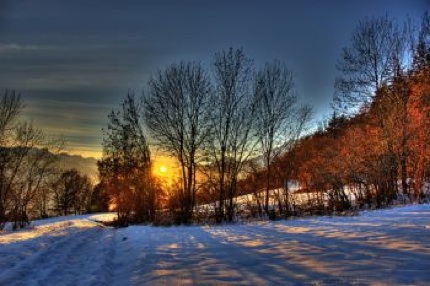Courtesy of EarthSky
A Clear Voice for Science
Visit EarthSky at
www.EarthSky.org

 The 2010 solstice comes on December 21, but the earliest sunsets for the northern hemisphere are around now.
The 2010 solstice comes on December 21, but the earliest sunsets for the northern hemisphere are around now.
It seems paradoxical. At middle latitudes in the U.S. – and throughout the northern hemisphere – the earliest sunsets of the year come about two weeks before the solstice and the shortest day of the year.
Everything you need to know about the solstice on December 21
Why isn’t the earliest sunset on the year’s shortest day? It is because of the discrepancy between the clock and the sun. A clock ticks off exactly 24 hours from one noon to the next. However, the actual days – as measured by the spin of the Earth, from what is called one “solar noon” to the next – rarely equals 24 hours exactly.
Solar noon is also called simply “midday.” It refers to that instant when the sun reaches its highest point for the day. At this time of year, the period from one solar noon to the next is actually half a minute longer than 24 hours. Today, the sun reaches its noontime position at 11:52 a.m. local standard time. Two weeks from now – on the winter solstice – the sun will reach its noontime position at 11:59 a.m. that is 7 minutes later than today.
The later clock time for solar noon also means a later clock time for sunrise and sunset. The table below helps to explain.
For Philadelphia, Pennsylvania
|
Date |
Sunrise |
Solar Noon (Midday) |
Sunset |
Daylight Hours |
|
December 7 |
7:09 a.m. |
11:52 a.m. |
4:35 p.m. |
9 hours 26 minutes |
|
December 21 |
7:19 a.m. |
11:59 a.m. |
4:39 p.m. |
9 hours 20 minutes |
The above image is from jayhem’s photostream.
The exact date for the earliest sunset or earliest sunrise varies by latitude. At present, mid-temperate latitudes in the northern hemisphere have their earliest sunsets, while the southern hemisphere’s mid-temperate latitudes are waking up to their earliest sunrises. At latitudes closer to the equator, the earliest sunset or earliest sunrise has already come and gone. Closer to the Arctic and Antarctic Circles, the earliest sunset and earliest sunrise have yet to come.
As you might have guessed, the latest sunrises and sunsets are not on the day of the solstice either.
So there is variation in the exact dates, but the sequence is always the same for both hemispheres. First: earliest sunset before the winter solstice, the winter solstice itself, latest sunrise after the winter solstice. Half a year later: earliest sunrise before the summer solstice, the summer solstice itself, latest sunset.
The earliest and latest sunsets and sunrises are lovely phenomena that happen around every solstice. People around the world notice them and often ask about them.
Written by Bruce McClure
Astronomy Picture of the Day from NASA/JPL
U.S. Naval Observator Astronomical Information center
The York County Astronomical Society
 Print This Post
Print This Post








